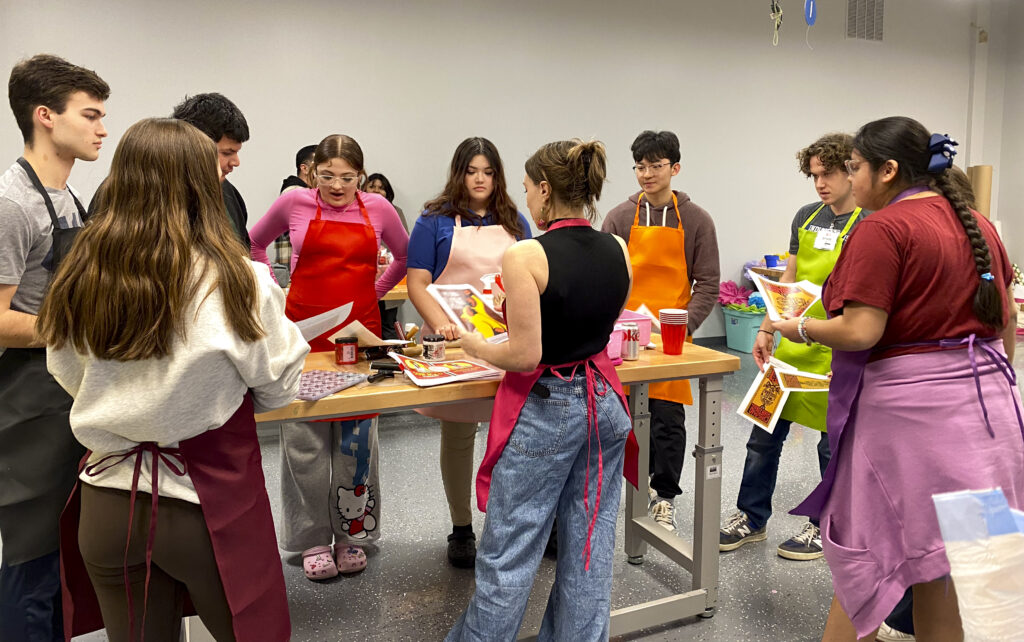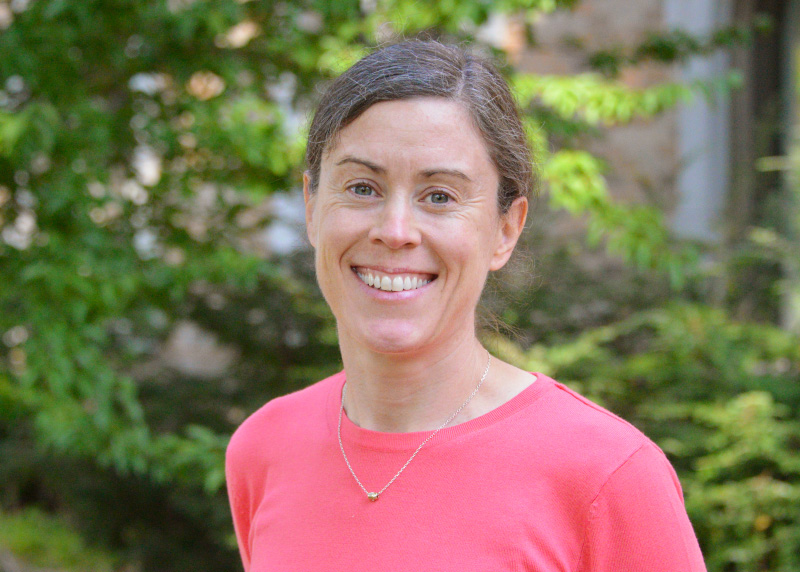Printmaking history
Institute partners with community to celebrate South Bend’s Latino heritage
June 18, 2025
Through a partnership between La Casa de Amistad and the Institute for Social Concerns at the University of Notre Dame during the spring semester, local Latino high school students not only learned about Latino history—they took part in making it.

Each Monday throughout the semester, Geneva Hutchinson joined La Casa’s after-school program Adelante for printmaking workshops. A postdoctoral research scholar at the institute, Hutchinson is an artist and educator with a master of fine arts degree in studio art from Notre Dame. As part of her postdoctoral work at the institute, she partners with organizations in South Bend to provide local youth opportunities to learn about their cultural heritage through art.
In partnering with the Adelante program, Hutchinson drew on her bachelor of fine arts in printmaking from Clemson University. “Printmaking has deep roots in Mexican culture,” Hutchinson explained, “going back to the establishment of the first printing press in the Americas in Mexico City in 1539.”

At each printmaking workshop, students learned printmaking techniques like monotyping and linocutting while also reflecting on how printmaking has been used for centuries as a form of storytelling in Hispanic culture. These workshops also spurred them on to reflect on how they could use their newfound printmaking skills to tell a story.
“At the institute, we engage with the arts as a way to amplify marginalized voices and give us an insight into the experiences of others,” Hutchinson stated. “By engaging with prints created by Latino artists and creating their own, this work gives these teens an opportunity to have conversations about migration, labor, and other subjects that would have been difficult to have without the art.”
The workshops came alive when students were invited to contribute their printmaking work to a mural honoring the founders of the Mexican-American Baseball League.
“At the institute, we engage with the arts as a way to amplify marginalized voices and give us an insight into the experiences of others.”
Beginning in the 1960s, South Bend–area photographer Rene Francisco Garza Sr. documented the experiences of Latino migrant families in South Bend—from working in the fields, to celebrating weddings and quinceañeras, to accompanying labor leader Cesar Chavez to a speech at Notre Dame in 1979, to founding the Mexican-American Baseball League.
When the curator of the Indiana University South Bend Civil Rights Heritage Center discovered Garza’s photography collection, he knew each photograph had a story to tell. All they needed was someone to identify and tell their stories, and that’s where the institute came in.
As community partnerships and programs managing director at the institute, Michael Hebbeler regularly teaches the institute’s Art and Social Change course. Students in the course work with community partners and, with the guidance of a local artist, work to create an artistic piece that serves the good of the community.
Previously, the course partnered with local artist and educator Freddy Rodriguez on a mural at La Casa commemorating the journey of people who immigrate to the United States. When Hebbeler was contacted about Garza’s photography and learned that Rodriguez’s father, Chico, was one of the founders of the baseball league, the pieces started falling into place.
Last summer Hebbeler gathered the league’s founders at La Casa to share their stories. In addition to baseball, the conversation turned to the early days of Latino community organizing in South Bend.

After founding the Mexican-American Baseball League in South Bend in the 1960s, many of the league’s organizers went on to become leaders in the community, including founders of La Casa, staff in the mayor’s office, one of South Bend’s first Latino fire chiefs, and even a Major League Baseball player. One of the threads that emerged from their conversation was that organizing the baseball league in the 1960s was a catalyst for organizing the Latino community in the decades that followed.
To help tell their story, Hebbeler commissioned Rodriguez to create a mural at Southeast Community Park in South Bend. He enlisted his Art and Social Change students to provide the research. In addition to archival research at the Civil Rights Heritage Center and Notre Dame’s Hesburgh Library, students conducted oral interviews with the baseball league’s founders and other Latino community leaders.
In the course of their research, the Notre Dame students unearthed articles in the South Bend Tribune from the 1960s and ’70s about the baseball league and Latino community organizing. They brought these articles to the Adelante students to incorporate into their printmaking projects.
“As we sifted through headlines from The South Bend Tribune,” Adelante coordinator Roberto Leal recalled, “I quickly realized that this story belongs to our parents and their parents. That this story, the story of struggles and triumphs and community building, is one that took place right here—a place many of us today call home.”
Together, the Notre Dame and Adelante students—along with their instructors and Rodriguez—determined that there were two major aspects to the story they wanted to tell: struggle and freedom. They split the mural into a left side representing the civil rights struggle of the Latino community and the right side representing the freedom that resulted from that struggle. In the middle, they featured members of the baseball league along with Tribune articles overlaid with linocut prints designed by the students.
Gracie Eppler, a Notre Dame senior in the Art and Social Change course, shared, “I’ve connected not just with the students, but with past Latinos who have made an impact in this community, learning about their past trials as migrant farmers—and how art can be used as expression in times of oppression.”
“This story, the story of struggles and triumphs and community building, is one that took place right here—a place many of us today call home.”
On a sunny Friday afternoon in May, La Casa and the institute held a public ceremony to dedicate the mural and celebrate all those involved in its creation, including the league founders who shared their stories, the students who gathered the stories and brought them to life through art, Garza whose photography provided the impetus and inspiration for the mural, and Rodriguez who designed the mural and oversaw its creation.
Institute director Suzanne Shanahan, La Casa CEO Juan Constantino, and South Bend mayor James Mueller each offered greetings to the large crowd gathered for the event. Various people involved in the creation of the mural, including Notre Dame and Adelante students, shared what it meant to be a part of telling the story of the Latino community’s struggles and achievements in South Bend. The ceremony concluded with a mural blessing by Father Ryan Pietrocarlo, C.S.C., pastor at St. Adalbert Parish in South Bend. Afterward, attendees enjoyed tacos and soft drinks while browsing copies of the students’ printmaking.

“Being a part of a community can help us feel connected to others as well as feeling like part of something larger than ourselves,” said Adelante student Yazid Ocampo at the event. “The thing I will take away from this project is being able to create something great with others.”
“At the institute, we say we’re animated by a normative proposition.” Shanahan stated in her remarks. “Our proposition is that a just world is a beautiful world. And so today is a really spectacular day for us because we’re bringing the pursuit of justice together with outstanding beauty.”
“This has been just a genius collaboration,” she added, “and we can’t wait to do the next one.”
For more on the event, see the stories at ABC57 and The South Bend Tribune. See also “Las Tejanas: From the Rio Grande Valley to South Bend’s west side” by Art and Social Change student Valeria Bautista Misakova.
Related Stories
-
Suzanne Mulligan on ‘Dilexi Te’—a spotlight on increasing inequality
-
ReSearching for the Common Good: Jenifer Guadalupe Solano Becerra
-
Engaging South Bend—University faculty explore research collaborations with regional organizations through institute’s Engage South Bend tour
-
Two paths, one destination—Postbaccalaureate research fellows join the institute to research mass incarceration
-
Extraordinary good for this world—Researching for the Common Good Symposium celebrates undergraduate summer research





